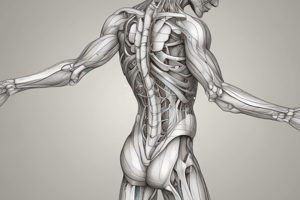Podcast
Questions and Answers
What is a major difference between intracapsular and extracapsular fractures of the neck of femur?
What is a major difference between intracapsular and extracapsular fractures of the neck of femur?
- Intracapsular fractures are less likely to cause complications.
- Extracapsular fractures occur within the joint capsule.
- Extracapsular fractures are more likely to result in avascular necrosis.
- Intracapsular fractures are more likely to result in avascular necrosis of the femoral head. (correct)
Which ligament is primarily involved in the terrible triad injury of the knee?
Which ligament is primarily involved in the terrible triad injury of the knee?
- Achilles tendon
- Lateral collateral ligament
- Anterior cruciate ligament (correct)
- Patellar ligament
What condition results from excessive and repetitive loads causing inflammation of the periosteum?
What condition results from excessive and repetitive loads causing inflammation of the periosteum?
- Hammertoe
- Foot drop
- Shin splints (correct)
- Baker’s cyst
Which nerve innervates the quadriceps muscle group?
Which nerve innervates the quadriceps muscle group?
Foot drop is primarily associated with damage to which nerve?
Foot drop is primarily associated with damage to which nerve?
What structure does the sciatic nerve split into?
What structure does the sciatic nerve split into?
Which demographic is more likely to experience traumatic hip dislocation?
Which demographic is more likely to experience traumatic hip dislocation?
Which compartment of the thigh does the obturator nerve primarily innervate?
Which compartment of the thigh does the obturator nerve primarily innervate?
Which of the following muscles is NOT innervated by the tibial nerve?
Which of the following muscles is NOT innervated by the tibial nerve?
What is a common reason for sciatica?
What is a common reason for sciatica?
What is a common injury associated with the gluteus medius and minimus muscles?
What is a common injury associated with the gluteus medius and minimus muscles?
Which muscle originates from the iliac fossa and is responsible for hip flexion?
Which muscle originates from the iliac fossa and is responsible for hip flexion?
What anatomical structure can be affected by piriformis syndrome?
What anatomical structure can be affected by piriformis syndrome?
What action do the adductor muscles primarily perform?
What action do the adductor muscles primarily perform?
What is a potential consequence of insufficient blood flow in the lower limb?
What is a potential consequence of insufficient blood flow in the lower limb?
Which compartment of the lower limb contains the quadriceps femoris group?
Which compartment of the lower limb contains the quadriceps femoris group?
What is the primary action of the gastrocnemius muscle?
What is the primary action of the gastrocnemius muscle?
Which muscle is involved in unlocking the knee joint?
Which muscle is involved in unlocking the knee joint?
What condition is characterized by overuse and excessive forces on the knee leading to tibial tuberosity avulsions?
What condition is characterized by overuse and excessive forces on the knee leading to tibial tuberosity avulsions?
What are the main actions of the biceps femoris muscle?
What are the main actions of the biceps femoris muscle?
Flashcards are hidden until you start studying
Study Notes
Lower Limb Skeleton Anatomy
- Pelvis and hip structure critical for weight-bearing and mobility.
- Fractured neck of femur categorized as intracapsular (risk of avascular necrosis) or extracapsular (e.g., intertrochanteric).
Surgical Treatments
- Cannulated and dynamic hip screws employed for neck of femur fractures.
- Total Hip Replacement (THR) indicated for severe hip joint damage.
Hip and Pelvis Ligaments
- Hip dislocations common in congenital development (DDH) or elderly trauma patients.
Knee Anatomy
- Anterior cruciate ligament (ACL) and posterior cruciate ligament (PCL) crucial for knee stability.
- Meniscal tears (medial and lateral) often present with ACL injuries in the "Terrible Triad" (MCL, ACL, medial meniscus).
Lower Limb Complications
- Shin splints arise from excessive loading causing periosteal inflammation.
- Baker’s cyst forms due to knee joint pathology.
Nerve Function and Innervation
- Lumbo-sacral plexus significant for lower limb nerve supply:
- Obturator nerve: L2-L4, innervates adductor muscles.
- Femoral nerve: L2-L4, innervates quadriceps and hip flexors.
- Sciatic nerve: L4-S3, innervates most of the leg, splits into tibial and common fibular nerves.
- Common fibular nerve injury leads to foot drop; deficient dorsiflexion observed.
Blood Supply and Complications
- Deep vein thrombosis (DVT) related to weak or damaged venous valves, causing pooling.
- Varicose veins develop from venous stretching and twisting.
Major Muscle Groups
- Hip Flexors: Iliacus and psoas major flex the hip; insert at lesser trochanter.
- Gluteal Muscles: Gluteus maximus, medius, and minimus involved in extension, abduction, stabilization.
- Quadriceps: Extends the knee; stabilizes during movement, crucial for sports injuries.
Knee Stabilizers and Potential Injuries
- Compartment syndrome can occur due to excessive pressure in muscle compartments.
- Patellar maltracking might lead to patellofemoral syndrome from overuse, weak muscles.
Adductor Muscles
- Adductor magnus is the largest and most powerful; has two parts for hip adduction and extension.
- Common groin injuries often affect adductor group muscles.
Additional Muscle Details
- Pes anserinus: site for sartorius, gracilis, and semitendinosus muscle attachment.
- Key plantarflexors include gastrocnemius, soleus, and tibialis posterior; popliteus muscle "unlocks" the knee.
Clinical Relevance
- Piriformis syndrome: potential sciatic nerve compression due to anatomical positioning.
- Chronic conditions like trochanteric bursitis connected with gluteal muscle injuries.
These notes encapsulate essential aspects of lower limb anatomy, significant injuries, and relevant musculature and nerve supply for clinical practice and anatomical understanding.
Studying That Suits You
Use AI to generate personalized quizzes and flashcards to suit your learning preferences.




